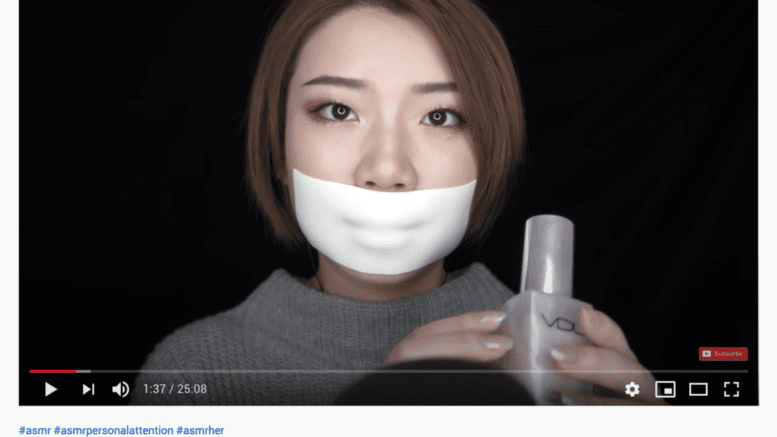She tapes her mouth with latex-free surgical tape, then places another piece across the camera lens to “silence” her audience. Moving slowly, she mimics the motion of applying foundation with a yellow sponge and gently strokes brushes across palettes of eye shadow and blush.
These is one of dozens of videos made by Kelly, who requested her last name not be used. She is a Toronto-based ASMR artist at home.
ASMR — which is also known as an autonomous sensory meridian response — is a growing movement on social media, particularly YouTube. According to a study published in 2018, many people are triggered by the sounds of whispering, typing or crunching apples, among others.
These videos allow viewers to experience a sense of relaxation or a warm, tingling sensation spreading from the scalp into the body. Some people even say these videos help them sleep.
“I love being an ASMR artist because it makes me feel like I’m doing meaningful work and being able to help people is a different level of satisfaction compared to my daytime job,” Kelly said in a Skype interview. “And having creative freedom is what makes me feel like a true artist.”
Known as ASMR her on YouTube, Kelly started her channel in 2018. Her videos have thousands of views. She was previously a full-time content creator on YouTube who focused on fashion and DIY-related videos.
Watch the highlights of interviews with ASMR creators:
By day, Kelly is a digital graphic designer who works in an intense and stressful environment, so she was intrigued by the idea of using ASMR for relaxation and meditation.
“Being a part of society, you’re always going to meet failure and disappointments. I think people criticize more than they praise,” she said.
“I would say the positive affirmation of ASMR brought to my attention. The creator would reassure the audience by using words like, ‘You’re going to be fine,’ and, ‘You’re strong.’ These are motivational and are ways of spreading positivity.”
WhisperingLife ASMR is believed to have been the first content creator to release an intentional ASMR video on YouTube in 2009. According to statistics of Google Internal Data, YouTube searches for ASMR boomed over 200 per cent in 2015, and the trend is still on the rise.
Among the thousands or millions of ASMR videos on YouTube, it was never an easy task for Kelly to stand out from the crowd. Mouth taping and “no talking” ASMR videos have become her calling card.
She once received a heartwarming comment on her from an ex-soldier from the Middle East who suffered from mental health problems and kept hearing noises in his head because of the bombing. Although he did not experience the tingles that some ASMR enthusiasts report, he told Kelly that her videos helped and made him feel relaxed.
Some people dismiss ASMR as pseudoscience, but it is widely popular nonetheless.
“It’s quite shocking to me, and it’s been largely overlooked by academics and health professionals which there’ve only been 11 published articles in peer-reviewed journals,” said The ASMR Psychologist, a London-based clinical psychologist who asked that her real name not be used. She started creating content on YouTube last year that combines ASMR and psychology.
“When I am working as a psychologist, it’s one to one. But working as an ASMR psychologist on YouTube can help thousands of people. You don’t become a psychologist just because you want to pay your mortgage,” she said in a Skype interview.
She is now working with a professor of psychology from Stanford University to study the psychology behind ASMR by conducting an online survey.
She does not think that ASMR can replace clinical psychology because the effects of ASMR seem to be short-lived. The technique doesn’t help to resolve the underlying issues, but is positive that it can be combined with psychology, she said.
“Some people said that they could feel defensive and quite anxious when they go into therapy, but ASMR could calm them and put them in a good place,” she said.
Natalia Rudu, 19, a second-year student at the University of Toronto, started exploring ASMR two years ago. Now she watches ASMR videos on YouTube every night.
“I was talking to my psychiatrist once about how I use ASMR videos to sleep because she was the one who prescribed my sleep medications, but the fact was a lot of psychiatrists and psychologists don’t have an understanding of what it is,” Rudu said.
Read more from the Toronto Observer:
She was diagnosed of anxiety-related insomnia four years ago. Medications were not helping her, so she started using ASMR whispering videos as a sleep aid.
“I think ASMR is like an embarrassing thing to talk about because for whatever reason, people think that it’s like sex,” Rudu said.
Striking a balance between work and creating content on YouTube is difficult for Kelly and The ASMR Psychologist. They both face challenges of recording ASMR in a soundproofed room, given that both of them live near a busy road in Toronto and London respectively.
Kelly films inside her washroom, while The ASMR Psychologist has to put pillows beside her window.
Still, the biggest motivation for these artists to keep creating content is the audience engagement that they can receive, and the minute when they see a positive comment of how they have helped others.

